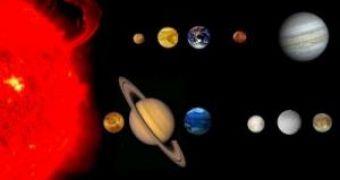Astronomers have discovered more than 200 extrasolar planets insofar, most of them being giant gas planets many times larger than Jupiter and orbiting very close to the star. It is estimated that around 10 percent of all stars have planetary systems (although some astronomers think this is an underestimation) and 40 percent of the 200 or so known planets around other stars are Hot Jupiters (although it is possible that the percentage will decrease as more distant planets are discovered).
A new study has now computed that a third of the solar systems having such a Jupiter-like gas giant close to the star (a "Hot Jupiter") also have Earth-like planets. Astronomers are interested in planets that may contain liquid water. Such a planet should be at a certain distance from the star, must be in the "habitable zone", and should have a certain size.
The "Hot Jupiters" are thought to have migrated inward toward their stars as the planetary systems were forming. According to the new study, authored by Raymond, Avi Mandell of both Penn State and Goddard Space Flight Center in Greenbelt, Md., and Steinn Sigurdsonn of NASA's Goddard Center, this inward motion must have the proto-planetary disk material during their journeys and has triggered the formation of ocean-covered, Earth-like planets in a "habitable zone" conducive to the evolution of life.
Rocky debris was pushed outward where it is likely to coalesce into Earth-like planets, said Raymond. At the same time, turbulent forces from the dense surrounding gas slow down the orbits of small, icy bodies in the outer reaches of the disk, causing them to spiral inward and deliver water to the fledgling planets. As a result of these two processes, such planets may eventually host oceans several miles deep.
"These gas giants cause quite a ruckus," said Raymond of CU-Boulder's Laboratory for Atmospheric and Space Physics. "We now think there is a new class of ocean-covered, and possibly habitable, planets in solar systems unlike our own."
The research team ran exhaustive simulations lasting more than eight months each on more than a dozen desktop computers, starting with proto-planetary disks containing more than 1,000 moon-sized, rocky and icy bodies. The initial conditions for each computer model were based on current theories of how planets form in our own solar system and simulated about 200 million years of planetary evolution.
The simulations revealed other surprises as well. In addition to the Earth-like planets in the habitable zones outside the "Hot Jupiters" they also show "Hot Earths" forming inside the "Hot Jupiters" orbits. Such a Hot Earth, with a radius twice that of our own Earth, was discovered in 2005 in a nearby star system orbiting just 2 million miles from its parent star by a team led by University of California, Berkeley, planetary scientist Geoffrey Marcy.
"Upcoming space missions such as NASA's Kepler and Terrestrial Planet finder and ESA's COROT and Darwin will discover and eventually characterize Earth-like planets around other stars," wrote the authors in Science. "We predict that a significant fraction of systems with close-in giant planets will be found to have a Hot Earth or potentially habitable, water-rich planets on stable orbits in the Habitable Zone."
The models suggest that both types of Earth-like planets would contain large amounts of water, up to 100 times the water present on Earth today, and lower amounts of iron. Iron might be important for evolution and might have a role during the oxygenation of the atmosphere.
According to the team's simulations, Hot Earths can form astoundingly fast, in just 100,000 years or so. Earth-like planets in habitable zones form much more slowly, taking up to 200 million years, said Raymond. Geologists believe Earth took about 30 million years to 50 million years to fully form.
"I think there are definitely habitable planets out there," said Raymond. "But any life on these planets could be very different from ours. There are a lot of evolutionary steps in between the formation of such planets in other systems and the presence of life forms looking back at us."

 14 DAY TRIAL //
14 DAY TRIAL //